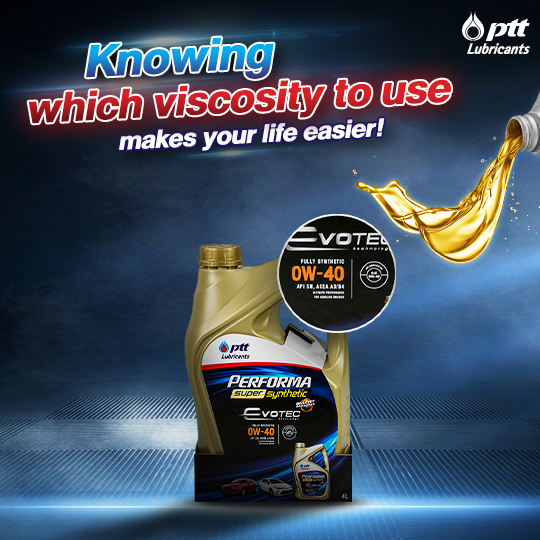
PTT Lubricants invites everyone to crack the secret code on the engine oil label, the "Viscosity Number". Let’s see which number is suitable for what type of car and how to choose it!
First, let's get to know the viscosity number for the lubricant used in "automotive".
The numbers listed are specified by the Society of Automotive Engineers (SAE), so the type of viscosity numbers start with “SAE” followed by a number. SAE numbers can be divided into 2 types as follows:
- Viscosity numbers for engine oil or crankcase oil tested according to SAE J300 standards with viscosity numbers in order from low to high: SAE 0W, 5W, 10W, 15W, 20W, 25W, 8, 12, 16, 20, 30, 40, 50 and 60
- Viscosity numbers for automotive gear oil used for manual transmissions, differentials, rear axles, etc., subjected to the SAE J306 standard, with viscosity numbers in order from low to high: SAE 70W, 75W, 80W, 85W, 65, 70, 75, 80, 85, 90, 110, 140, 190 and 250
We can see that the viscosity numbers in both groups have different sets of numbers even though some numbers have similar or overlapped viscosity ranges such as SAE 40, 50 and SAE 90. It is to prevent misapplication when used. Today we will talk about the viscosity number that is mainly related to engine oil.
Monograde such as SAE 10W, 30, 40 and 50
- Engine oil that is qualified in only one viscosity range.
- Winter grade viscosity numbers are followed by the letter "W". It indicates the ability to flow at negative temperatures, especially when starting an engine that the oil must be injected from the bottom sump through pump to lubricate various parts.
The lower the number, the lower the viscosity of the engine oil and the better ability to flow at very low negative temperatures. For example, SAE 0W can flow at temperatures as low as -40 degree celsius, while SAE 15W can only flow at temperatures as low as -25 degree celsius.
- Summer Grade viscosity, on the other hand, will not have the letter W after it.
The numbers indicate the viscosity range of high temperature engine oil (100 degree celsius), which is close to the normal operating temperature of the engine oil. The higher the number, the higher the viscosity. Higher numbers of the summer grade will also indicate greater film thickness and strength, especially in high shear resistance at high temperatures (150 degree celsius). In addition, higher viscosity oils have good metal surface adhesion and low evaporation rates which can reduce the depletion or oil consumption.
However, using too high viscosity will increase the resistance to the movement of various parts in the engine, affecting fuel consumption and acceleration response. Be sure to select a viscosity level that is suitable to the engine performance and the driver’s driving habits.
Multigrade such as SAE 0W-20, 0W-30, 0W-40 and 5W-40
- Engine oil that has the qualities of 2 viscosity range covering both winter and summer grade.
- The number on the front, such as SAE 0W, 5W, 10W and 15W, indicates a viscosity or ability to flow at low temperatures or when starting the engine. After the engine works for a while, the engine oil temperature will gradually rise and return to normal operating temperature. The later number, such as SAE 20, 30, 40 and 50, indicates the viscosity of the engine oil or the thickness/strength of the oil film.
- Multigrade viscosity oils have advantages over monogrades in terms of good fluidity to lubricate engine when starting. This, therefore, provides better protection against the wear that occurs often at start-up as it extends the life and maintains engine performance. In addition, the multigrade viscosity number has lower friction/resistance when the engine oil is heated up or when the temperature is low, reducing the fuel consumption while also responding well to the acceleration or engine lubricity. (The lower the number in front of W, the lower the friction and the faster the lubrication of the entire system). The multigrade viscosity oil also has a higher viscosity index than the monograde, making it able to maintain its viscosity better at high temperature and under various heat conditions, which affects wear protection. (The lower the number in front of W, the higher the viscosity index.)
How to choose the right viscosity number of the engine oil?
- Do consider choosing from the summer grade viscosity number or the number on the back first. For example, if your vehicle's manual recommends a viscosity number SAE 15W-40, select an engine oil with SAE 40 on the back number to ensure an adequate engine protection.
- Then choose the viscosity number in front of W, which you can either select SAE 15W as recommended by the manual or use a clearer number such as SAE 0W, 5W and 10W, depending on the needs of users in terms of price and performance. If you want a smooth acceleration response, good engine protection both at start-up and at extremely hot temperatures while also saving your money, choose a lower viscosity number for the front number, such as SAE 0W-40, etc.
Note: Choosing the right viscosity number is one of the important factors in choosing engine oil. However, you should consider choosing the quality standards that match those specified in the vehicle manual.